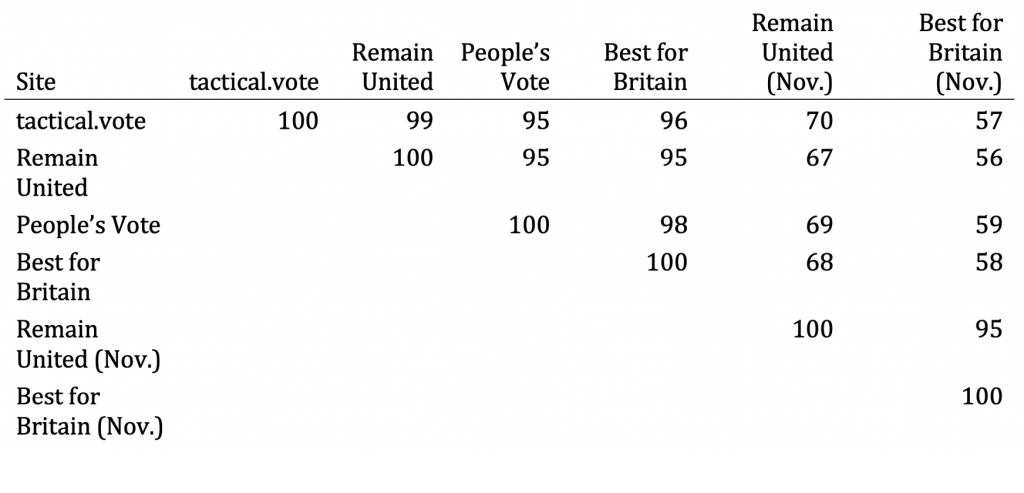
Prof Chris Hanretty
Professor of Politics at Royal Holloway, University of London. He works on public opinion and representation the UK, and in particular how to estimate public opinion at the local level. In 2018 he was one of the winners of the Philip Leverhulme Prize
Email: Chris.Hanretty@rhul.ac.uk
Twitter: @chrishanretty

Section 2: Voters, Polls and Results
- Boris’s missing women
- An expected surprise? An evaluation of polls and seat forecasts during the campaign
- Unprecedented interest or more of the same? Turnout in the 2019 election
- Cartographic perspectives of 2019 General Election
- Another election, another disappointment: Young people vote left and are left behind at GE2019
- Divided we fall: was Nigel Farage the kingmaker of the Johnson victory?
The dispersion of the Remain vote between multiple competing parties created strong incentives for coordination in 2019. Three “Remain” parties (the Liberal Democrats, the Greens, and Plaid Cymru) were able to coordinate at the elite level, agreeing a joint candidate in 60 seats, but this coordination was limited in comparison to the Brexit Party’s decision to stand aside in Conservative held-seats. In order to fill this “coordination gap”, several websites offering tactical voting advice sprung up.
Who were they?
It is not possible to list all these tactical voting advice sites which were created, so I discuss four sites which were particularly important during the campaign:
•getvoting.org, a site backed by Best for Britain, a campaign group “committed to finding a democratic way to stop Brexit”, chaired by former Labour minister Mark Malloch Brown, and set up before the 2017 general election.
•remainunited.org, a group set up by Gina Miller, the main litigant in the UK Supreme Court case Miller v. Secretary of State for Exiting the EU, and a former member of Best for Britain. Miller left Best for Britain shortly after the 2017 election, saying that the group had become more about stopping the Conservatives than stopping Brexit.
•peoples-vote.uk, a group with a strong degree of overlap with the 2016 Remain campaign, and which saw a significant staff mutiny during the course of the campaign.
•tactical.vote, “a project by the grassroots @votetools collective”, and which distinguished itself by providing a meta-analysis of recommendations made by different tactical voting campaigns.
How did they work?
Two sites (getvoting.org and remainunited.org) estimated current public opinion using multilevel regression and post-stratification (MRP), a technique for estimating opinion in small areas using large national samples. In most cases they recommended the non-Conservative candidate who was best placed according to this analysis. Because MRP relies on polling data, and because polling data can become out of date, these sites changed their recommendations over time. For example: the first Best for Britain recommendations were published on 3rd November, and were updated again on 28th November and 9th December.
tactical.vote made recommendations on the basis of 2017 election results. They recommended the best placed non-Conservative candidate, except where the Conservatives were a distant third place (in which case they make no recommendation), or where the seat is judged “unusual” (like the Speaker’s seat, or seats with independent candidates).
peoples-vote.uk made artisanal recommendations based on “talking to candidates… consulting leading pollsters, and analysing the results of local, European and national elections”.
How were they received?
The recommendations from Best for Britain were greeted with skepticism. This was motivated in part by the large number of recommendations to vote Liberal Democrat, concern over the freshness of the data, and some misunderstanding of how MRP works. As tactical voting advice sites multiplied over the course of the campaign, attention focused on constituencies where the sites offered differing recommendations, giving rise to articles with titles like “Can you trust tactical voting sites?”. This ignored the fact that most sites recommended the same party, and that most of the seats with differing recommendations were difficult to call by any measure. By the end of the campaign, most sites agreed on a large number of constituencies (see Table 1). Because Labour support grew over the course of the campaign whilst Liberal Democrat support shrunk, earlier differences between tactical.vote and MRP-based sites diminished.
getvoting.org and tactical.vote were more popular than remainunited.org or peoples-vote.uk. Best for Britain claimed that their site had 3.8 million unique visitors; the site’s Alexa page rank on the morning before the election (332,947) was beaten only by tactical.vote (231,484). These estimates very roughly match estimates from the British Election Studies team, who reported that 6% of respondents (2.75 million people when expressed as a proportion of the adult population) listed tactical voting websites as a source of information they use when considering how to vote.
What effects did they have?
The way in which Best for Britain based their recommendations on the result of an MRP model allows a neat test of their influence. If, for example, we were just to examine the swings towards the Liberal Democrat in seats where Best for Britain recommended the Liberal Democrats, we might over-estimate the site’s influence because the Liberal Democrats were always fated to do well in those seats, and the MRP model picked up on it. If, however, we compare seats in which Best for Britain just recommended the Liberal Democrats, because they were fractionally ahead their nearest Remain competitor in the MRP analysis, compared to seats where they were fractionally behind, then we can estimate the effect of the endorsement alone. This regression discontinuity design (see Fig. 1) shows that the effect of endorsements by Best for Britain was around four and a half percentage points. This is a huge effect – around two times the incumbency bonus, for example – but is robust to the inclusion of controls for incumbency and the presence of Plaid or Green candidates. Tactical voting advice seems to work and work well.



